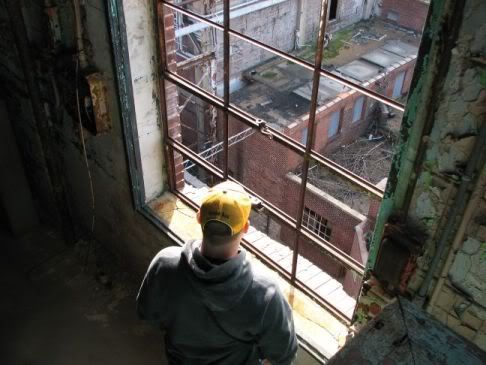St. Aloysius Gonzaga
 I have known that St. Aloysius has been getting closer and closer to demolition for awhile, and it has remained at the top of my list of places to visit. I had visited before, but had found the church and surrounding buildings to be fairly secure. Recently, I finally made the trip again by myself, and this time was able to gain entry and photograph the interior of the church, rectory, and old gymnasium. It seems such a waste that the Archdiocese of St. Louis is allowing this historic parish to be demolished to make way for luxury housing. A few locals told me that the church has settled considerable recently, and some of its structural flaws would be far to expensive to repair. Regardless, I hate to see any historic building meet its end in such a way.
I have known that St. Aloysius has been getting closer and closer to demolition for awhile, and it has remained at the top of my list of places to visit. I had visited before, but had found the church and surrounding buildings to be fairly secure. Recently, I finally made the trip again by myself, and this time was able to gain entry and photograph the interior of the church, rectory, and old gymnasium. It seems such a waste that the Archdiocese of St. Louis is allowing this historic parish to be demolished to make way for luxury housing. A few locals told me that the church has settled considerable recently, and some of its structural flaws would be far to expensive to repair. Regardless, I hate to see any historic building meet its end in such a way.Someone who is close to my family actually grew up attending "St. Al's," and her requests to see photos of the interior only made me want to visit more. As I began walking around the church interior, I knew that it may be something sh
 e would not like to see. You would never know that it has been closed for just over a year by the amount of debris lying around. One of the few features of the church to remain are the painted archways, which are still beautiful to behold. All the stained-glass windows have been removed, and I have been told will be sold for a hefty sum by the Archdiocese.
e would not like to see. You would never know that it has been closed for just over a year by the amount of debris lying around. One of the few features of the church to remain are the painted archways, which are still beautiful to behold. All the stained-glass windows have been removed, and I have been told will be sold for a hefty sum by the Archdiocese.I also visited the rectory that is attached to the church building via an inclosed walkway. It seemed to be almost in worse shape than the church itself, with grafitti having found its way into many of the rooms. It also appears that the entire complex has become an unofficial airsoft location. Only the frame of the main staircase in the rectory remains, and vandals have destroyed some of the windows and the first floor toilet (which was unfortunate because I REALLY had to go!) .
. 

 Finally, I made my way into the old school gymnasium. I don't usually explore by myself, but on this trip I felt completely comfortable aside from entering the pitch blackness of the gym basement. At one point, my flashlight came across a man standing in a corner. I nearly evacuated my bladder before I realized that it was a statue. Even then, the gesture he was making with his hands still made me a little uncomfortable.
Finally, I made my way into the old school gymnasium. I don't usually explore by myself, but on this trip I felt completely comfortable aside from entering the pitch blackness of the gym basement. At one point, my flashlight came across a man standing in a corner. I nearly evacuated my bladder before I realized that it was a statue. Even then, the gesture he was making with his hands still made me a little uncomfortable.
The gym floor was pretty unremarkable and empty. There was a fairly large stash of old trophies on the stage. It seems sad that kids probably worked very hard to achieve these tokens of athletic superiority, and now they are as forgotten as the church itself.
At this point, the demolition of St. Aloysius may be inevitable, as the developer's sign site prominently outside the front door of the church. However, there are those who are still battling to save this historic piece of St. Louis history. Visit http://www.savestaloysius.org/ if you would like to help or learn more. 



























































